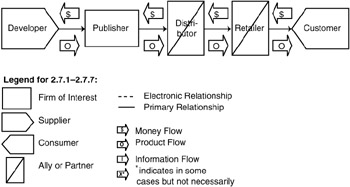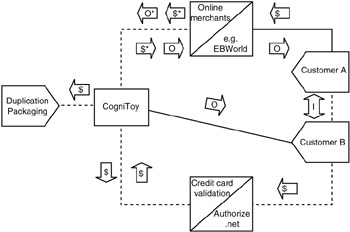Bypassing the Traditional Retail Model
Since the Web's inception, e-tailers have learned to harness the power of the Internet to reach thousands of would-be customers. The direct-to-customer business model bypasses intermediaries and ideally offers consumers a better value, better customer service, and increased convenience. The e-tailers, in exchange, might gain higher profit margins through cost reduction, product placement fees, and the sale of advertising space or customer data. The direct-to-customer business model can be extremely profitable, but its success depends on several key factors.
As [Weill and Vitale01] details, a successful direct-to-customer business must first capture customer awareness and then maintain interest through marketing or good press. The business must woo repeat customers by understanding their needs and by ensuring that transaction processing, fulfillment, and payment are conducted in a secure and efficient way. In addition, the product must be unique enough to deter price competition.
To the independent game developer, self-publishing and self-distribution via the Internet might be an appealing proposition because the game developer retains control over the product. However, the experiences of independent developers CogniToy and Digital Tome indicate that both retail and direct-to-customer markets can be difficult for self-publishers.
Traditional Retail Model
The traditional retail model, which is discussed fully in Articles 1.2 and 1.3, is a proven method to generate revenues. As shown in Figure 2.7.1, the publisher, the distributor, and the retailer all act as intermediaries between the developer and the customer.

Figure 2.7.1: In the traditional retail model, the publisher owns and controls the rights to the game. The developer supplies the game to the publisher, who then negotiates with distributors and retailers to reach the customer.
Each of these middlemen decreases profits for the developer. Even though the consumer might pay $50 at the store, the developer tends to receive little or none of that purchase price. Moreover, since the advance payment by the publisher is recoupable, the developer will not receive any royalties until the game's development costs have been fully repaid. From the standpoint of the game developer, this model tends to be more favorable to publishers.
CogniToy: Web and Retail Sales
Independent developer CogniToy chose to use the direct-to-customer approach and later expanded to traditional retail channels. Located in Acton, Massachusetts, CogniToy was founded in March 1997 to make "intelligent toys for intelligent minds." Its award-winning robot simulation game, Mind Rover: The Europa Project, was released in November 1999 and at that time, only available through CogniToy's Web site. Like other small companies on the Web, CogniToy used a third-party credit card validation service to facilitate sales.
Despite scanty advertising, Mind Rover sold pretty well via the Web site. Reviewers raved about CogniToy's first product. Within months, Mind Rover was available for purchase on Amazon, EBWorld, The Robot Store, and several other online sites. It sold so well at EBWorld, Electronics Boutique's online home, that the retail giant asked CogniToy to consider selling the game at its regular stores.
However, CogniToy soon found traditional retailing quite difficult. It lacked the marketing resources and the clout of the big software publishers to get in-house advertising or retail shelf placement. The company needed to package Mind Rover in a glossy four-color box for the retail version. Originally, Mind Rover had sold as a CD and manual only. To keep its cost per unit constant, CogniToy cut the 250-page manual down to 64 pages.
Moreover, since game retailers sell on consignment, a company only gets paid if the product sells. If it doesn't sell, the company pays to ship the unsold merchandise back. CogniToy found itself waiting months to get paid, if at all. While traditional retailing might have increased CogniToy's exposure, it yielded significantly less profit per copy than the Web site sale.
CogniToy's CTO Kent Quirk advises, "I would not recommend that small companies attempt to crack the retail market without knowing exactly what they're doing."
CogniToy's retail experience resembles that of Figure 2.7.1 while its online business model corresponds to Figure 2.7.2. Like other companies that sell direct-to-customer and also use intermediaries, there are potential channel conflicts. For example, the Web site sales might destabilize a relationship with the retailers. Instead, CogniToy could have pursued another revenue stream through the licensing of its technology. Indeed, it now sells a downloadable development kit to owners of the Lego RCX robot. In hindsight, Quirk admits that retailing might have been a bad decision for CogniToy. If there's a next time, CogniToy intends to leave retailing to a publisher.

Figure 2.7.2: CogniToy's self-published game, Mind Rover, was sold direct-to-customer via its Web site and through intermediaries. EBWorld, like its parent company, sells on consignment.
Digital Tome: Episodic Digital Distribution
Like CogniToy, Houston-based Digital Tome opted for a direct-to-customer model but with episodic downloads. Co-founders Van Collins and Jim Shiflett planned to digitally distribute what would be equivalent to a traditional retail CD. In 2000, Siege of Avalon, a single-player RPG in six chapters, was released over the course of several months. Three chapters were central to the story's plot while the other three were expansion chapters designed to give further opportunities to explore the fictional world. Players could purchase each chapter separately or all six in a bundle. This business model, depicted in Figure 2.7.3, had never been tested before.

Figure 2.7.3: Digital's Tome game, Siege of Avalon, was sold to consumers through a subscription or a la carte. Digital Tome paid Digital River, a third-party transaction company, a percentage of the sales.
Digital Tome soon ran into problems with customer expectations. Even in a downloadable format, gamers expected premium quality cinematics, voice actors, music files, and sound effects, all of which would necessitate huge file downloads. Without widespread access to broadband Internet access, such a huge download led to long and often costly download times.
Digital Tome also ran into high fixed costs for distribution. Digital River, a third-party transaction company, handled transactions and hosted the downloads. Since each chapter was larger than the download limit, penalties were assessed for each downloaded purchase.
Other potential customers resisted paying online for a downloadable product. They wanted a physical object in a box. In September 2001, Digital Tome released an anthology CD with a manual and additional content. This immediately caused a channel conflict, which led to the suspension of online subscriptions. Earlier U.S. customers had paid $35 for the 500MB download, while the retail product was selling in stores for $20. Consumers outside the United States complained that the cost of the subscription after exchange rates and download charges were about three times more expensive than the box.
In 2002, Digital Tome ceased new product development and the co-founders launched Expedition Games. Despite the difficulties, Shiflett still believes in the future viability of digital distribution. Certainly, digital distribution, if it's convenient, secure, and profitable, has the potential to overtake the traditional retail market. However, even in 2002, broadband penetration rates in the United States are lower than expected, and according to the International Intellectual Property Alliance, billions of dollars are lost through software piracy each year.
EAN: 2147483647
Pages: 275
- Article 225 Outside Branch Circuits and Feeders
- Article 285 Transient Voltage Surge Suppressors (TVSSs)
- Article 411: Lighting Systems Operating at 30 Volts or Less
- Article 702 Optional Standby Systems
- Example No. D8 Motor Circuit Conductors, Overload Protection, and Short-Circuit and Ground-Fault Protection